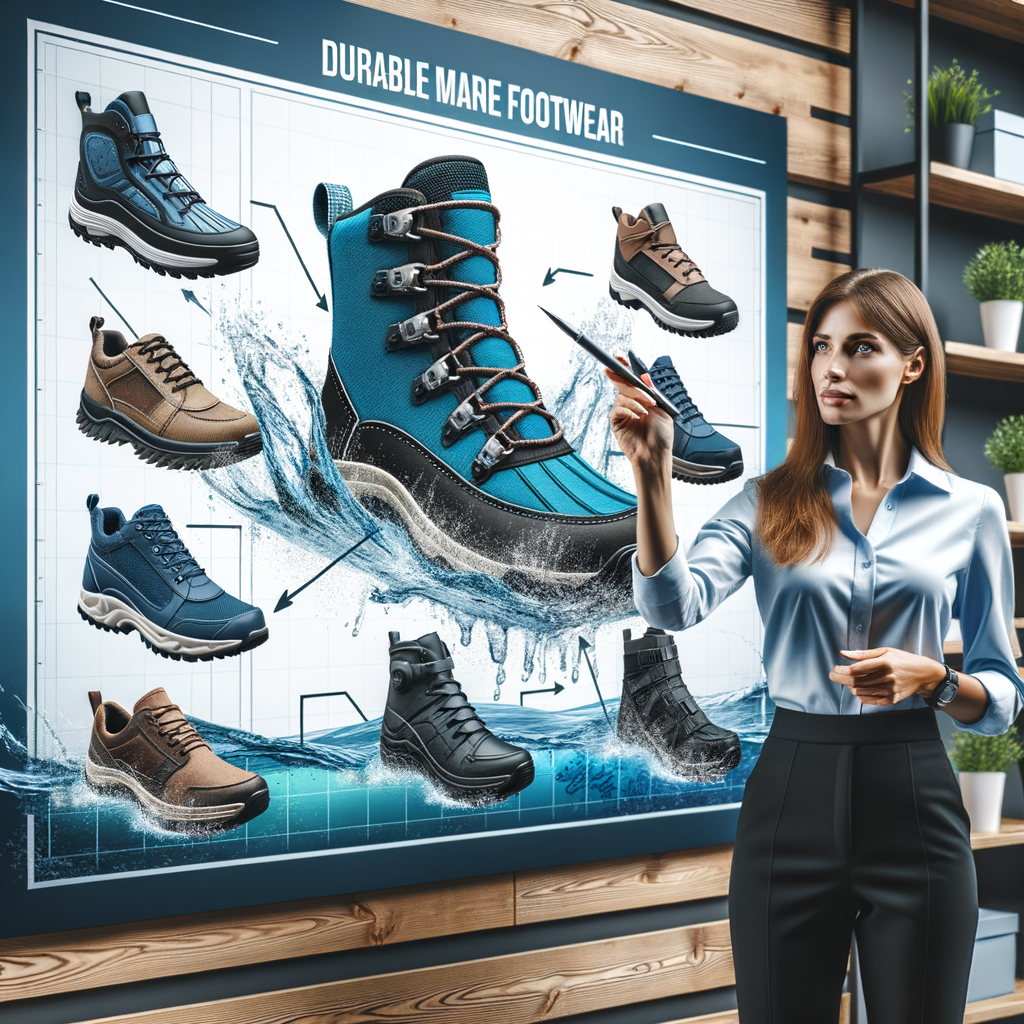
Introduction to Marine Footwear Selection
When embarking on a marine adventure, the right footwear can make all the difference. In this guide, we will explore the importance of selecting the right marine shoes and understand the challenges of extreme environments. Let’s dive in!
- Importance of Choosing the Right Marine Shoes
- Understanding the Challenges of Extreme Environments
Choosing the right marine shoes is crucial for your safety and comfort. The right shoes can protect your feet from sharp objects, keep them dry in wet conditions, and provide the necessary grip on slippery surfaces. They can also help prevent foot fatigue and injuries, enabling you to enjoy your marine adventure to the fullest.
Marine environments can be harsh and unpredictable. They can expose you to a variety of challenges such as wet and slippery surfaces, sharp rocks, cold temperatures, and even harmful marine life. Therefore, it’s important to choose footwear that is designed to withstand these conditions. Marine shoes should be waterproof, durable, and provide excellent grip and insulation.
In the following sections, we will delve deeper into the types of footwear suitable for marine environments, provide a guide to selecting the right shoes, and share some case studies of footwear that have proven effective in harsh marine conditions. Stay tuned!
Understanding Footwear for Extreme Environments
When it comes to extreme environments like the marine world, your footwear plays a crucial role. It can mean the difference between a successful adventure and a potentially dangerous situation. Let’s delve into the characteristics that make marine footwear durable and reliable.
Characteristics of Durable Marine Footwear
Marine footwear needs to be robust and resilient to withstand the harsh conditions of the sea. Here are some key characteristics to look for:
- Material and Construction
- Water-Resistance and Drainage
- Slip-Resistance and Grip
The material of the shoe should be tough enough to resist wear and tear. Look for materials like leather or synthetic mesh that are known for their durability. The construction of the shoe is equally important. Shoes with double or triple stitching tend to last longer.
Marine footwear should be water-resistant to keep your feet dry. But, they should also have good drainage to let out any water that does get in. This prevents your feet from staying wet, which can lead to discomfort or even health issues like athlete’s foot.
Slippery decks and wet rocks are common in marine environments. Therefore, your shoes should have a strong grip and be slip-resistant. This can prevent accidents and ensure your safety while you’re on your marine adventure.
Understanding these characteristics can help you choose the right footwear for your marine adventures. Remember, the right shoes can not only enhance your experience but also keep you safe.
Importance of Comfort in Extreme Environment Footwear
When it comes to footwear for extreme environments, comfort is just as important as durability. Let’s explore why comfort is crucial and how it can be achieved in marine footwear.
- Proper Fit and Sizing
- Cushioning and Support
- Breathability and Temperature Regulation
Footwear that doesn’t fit correctly can cause discomfort, blisters, and even injuries. It’s essential to choose shoes that are the right size for your feet. Too tight, and they can restrict blood flow; too loose, and they can cause instability. Remember, your feet may swell in hot conditions, so consider this when selecting your size.
Good cushioning can absorb shock, reducing the impact on your feet and joints. This is particularly important in rough terrains where you might be walking or running on hard surfaces. Additionally, proper support can help maintain the natural shape of your foot, preventing conditions like flat feet or overpronation.
Footwear that breathes well can help regulate the temperature of your feet, keeping them cool in hot conditions and warm in cold ones. This is crucial in extreme environments where temperatures can vary greatly. Breathable shoes also reduce the risk of fungal infections by keeping your feet dry.
In conclusion, comfort in extreme environment footwear is not just about feeling good; it’s about ensuring your safety and health. So, when selecting your marine footwear, remember to consider the fit, cushioning, and breathability of the shoes.
Guide to Selecting Shoes for Marine Use
When it comes to selecting shoes for marine use, it’s crucial to understand the conditions you’ll be facing. This includes understanding the terrain, weather and water conditions, as well as the duration and intensity of use. Let’s delve into these factors.
Assessing the Marine Conditions
-
Understanding the Terrain
The terrain is a key factor in choosing the right marine shoes. Whether you’ll be walking on sandy beaches, rocky shores, or slippery boat decks, your shoes need to provide the right grip and support. For instance, if you’ll be on a rocky terrain, you’ll need shoes with sturdy soles and good ankle support. On the other hand, if you’ll be on a boat deck, shoes with non-slip soles would be ideal.
-
Weather and Water Conditions
Weather and water conditions greatly affect the type of shoes you should wear. In warm, sunny weather, breathable shoes are best to keep your feet cool. If you’ll be in cold, wet conditions, waterproof and insulated shoes are a must. Additionally, if you’ll be in saltwater, consider shoes that are resistant to corrosion.
-
Duration and Intensity of Use
The length of time and the intensity at which you’ll be using your shoes also play a role in your selection. If you’ll be using them for long periods, comfort is key. Look for shoes with good cushioning and arch support. If your marine activities are intense, such as hiking or climbing, you’ll need durable shoes that can withstand the wear and tear.
In conclusion, understanding the marine conditions is the first step in selecting the right shoes. By considering the terrain, weather and water conditions, and the duration and intensity of use, you can make an informed decision and choose the best shoes for your marine adventures.
Comparing Different Footwear Options
When choosing marine footwear, it’s crucial to compare different options. Let’s take a closer look at boots, shoes, and sandals, as well as brand comparisons and the relationship between price and quality.
-
Boots vs Shoes vs Sandals
Boots, shoes, and sandals each have their own advantages and disadvantages when it comes to marine use.
Footwear Advantages Disadvantages Boots Provide excellent support and protection. They are ideal for rough terrains and colder climates. They can be heavy and may take longer to dry. Shoes Lighter than boots and offer good support. They are suitable for moderate terrains and climates. They may not provide as much protection as boots. Sandals Lightweight and quick to dry. They are perfect for warm climates and easy terrains. They offer less protection and support. -
Brand Comparisons
Not all footwear brands are created equal. Some brands are known for their durability, while others are known for their comfort. It’s important to research and compare brands before making a purchase. For example, Brand A might be known for their sturdy boots, while Brand B might be famous for their comfortable sandals.
-
Price vs Quality
The price of marine footwear can vary greatly. However, a higher price doesn’t always mean better quality. Sometimes, you are just paying for the brand name. It’s important to read reviews and check the materials and craftsmanship of the footwear. Remember, a good pair of marine footwear is an investment that should last for many adventures.
Case Studies: Footwear for Harsh Marine Conditions
Let’s delve into some real-life examples that highlight the importance of choosing the right footwear for marine environments. We’ll look at a success story and a cautionary tale that underline the necessity of water-resistance and slip-resistance in shoes.
-
Success Story: Using Water-Resistant Shoes in Wetlands
Meet John, an avid birdwatcher who often ventures into wetlands for his hobby. Initially, he faced a lot of trouble with his regular shoes. They would get soaked, making his trips uncomfortable and even leading to skin problems.
John decided to invest in a pair of water-resistant shoes designed specifically for marine environments. The result? His trips became much more comfortable. The shoes kept his feet dry, even in the wettest conditions. Plus, they were durable and lasted a long time, saving him money in the long run.
John’s story highlights the importance of water-resistant footwear in marine environments. It’s not just about comfort, but also about health and cost-effectiveness.
-
Cautionary Tale: The Importance of Slip-Resistance
Now, let’s look at a cautionary tale. Sarah, a marine biologist, often had to walk on slippery surfaces near the sea. She thought her regular shoes were enough until one day, she slipped and sprained her ankle.
After her recovery, Sarah decided to invest in slip-resistant marine footwear. These shoes provided better grip on slippery surfaces, reducing her risk of falls and injuries. She could now focus on her work without worrying about her safety.
Sarah’s experience underlines the importance of slip-resistance in marine footwear. It’s a crucial feature that can prevent accidents and ensure your safety.
In conclusion, both water-resistance and slip-resistance are vital features in footwear for marine environments. As we’ve seen from John and Sarah’s experiences, the right shoes can make a big difference in comfort, safety, and overall experience.
Key Takeaways: Marine Environment Shoe Guide
As we wrap up our discussion on marine footwear selection, let’s take a moment to review the most important points. These key takeaways will guide you in making the best choice when it comes to footwear for marine environments.
- Choose for the Conditions, Not Just the Style
- Invest in Quality for Safety and Durability
- Always Try Before You Buy
While the design and style of marine shoes are important, the primary factor to consider should be the conditions you’ll be facing. Are you going to be in a wet, slippery environment? Or will you be on a dry, rocky terrain? The right shoes can make all the difference in your comfort and safety. For example, in a study of marine workers, those who chose footwear based on the conditions reported fewer slips, trips, and falls.
Quality is key when it comes to marine footwear. High-quality shoes not only last longer, but they also provide better protection. They are typically made with durable materials that can withstand harsh conditions, and they often have safety features like slip-resistant soles or reinforced toes. Investing in quality footwear can save you money in the long run, as you won’t have to replace your shoes as often.
Finally, always try on marine shoes before you buy them. Even the highest-quality shoe won’t do you any good if it doesn’t fit properly. When trying on shoes, make sure there’s enough room for your toes to move, but not so much that your foot slides around. And remember, the right fit can make a world of difference in your comfort and safety.
In conclusion, choosing the right footwear for marine environments is a crucial decision. By considering the conditions, investing in quality, and ensuring a good fit, you can ensure that your marine adventures are safe and enjoyable.
Conclusion: Your Adventure Awaits
As we wrap up our comprehensive guide on selecting sturdy footwear for extreme marine adventures, it’s time to put your newfound knowledge to the test. The right pair of shoes can make all the difference when you’re exploring the wonders of the marine world. Remember, your adventure awaits!
- Final Thoughts on Selecting Sturdy Footwear for Extreme Marine Adventures
Choosing the right footwear for your marine adventures is more than just a matter of comfort. It’s about safety, durability, and the ability to withstand the harsh conditions that come with the territory. Here are some final thoughts to keep in mind:
1. Safety First: Always prioritize safety when choosing your footwear. Look for shoes with non-slip soles and adequate ankle support to prevent slips and falls.
2. Durability Matters: The marine environment can be harsh and unforgiving. Your shoes should be able to withstand the elements, from salty water to rocky terrains.
3. Comfort is Key: Comfort should never be compromised. Choose shoes that fit well and provide ample cushioning for your feet.
4. Consider the Environment: Different marine environments require different types of footwear. What works for a beach adventure may not be suitable for a deep-sea diving expedition.
Remember, the right footwear can enhance your marine adventure and ensure you’re well-equipped to explore the wonders of the sea. So, choose wisely and let the adventure begin!









